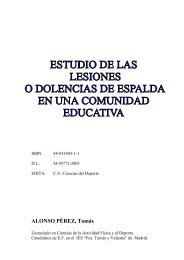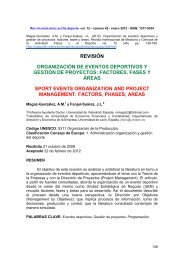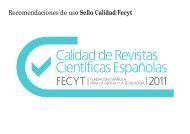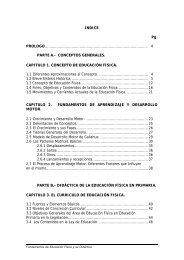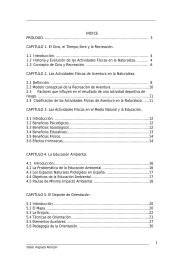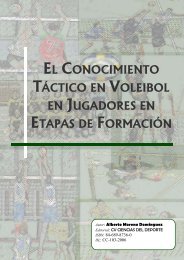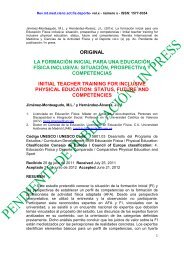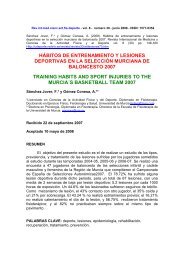English - Comunidad Virtual CIENCIAS DEL DEPORTE - RedIRIS
English - Comunidad Virtual CIENCIAS DEL DEPORTE - RedIRIS
English - Comunidad Virtual CIENCIAS DEL DEPORTE - RedIRIS
Create successful ePaper yourself
Turn your PDF publications into a flip-book with our unique Google optimized e-Paper software.
Rev.int.med.cienc.act.fís.deporte- vol. 13 - número 49 - ISSN: 1577-0354<br />
All the participants in this study were informed about the nature of it and<br />
volunteered to be part of the research.<br />
Table 1. Characteristics of the participants (FS: futsal; HH: hockey; S: sedentary women)<br />
FS HH S TOTALS<br />
N 11 12 10 33<br />
AGE 23.2 (±3.28) 21.9 (±3.75) 22.8 (±1.32) 22.6 (±3)<br />
WEIGHT 59.464 (±4.699) 62.5 (±6.32) 64.98 (±10.55) 62.239(±7.55)<br />
HEIGHT 162.4 (±6.36) 166.3 (±5.754) 168 (±4.163) 165.485(±5.87)<br />
Inclusion criterion for the HH and FS group were: be federated in their<br />
corresponding sports federation and have been practicing their sport<br />
competitively for at least two years (Elvira et al., 2008a). Finally, it was<br />
considered necessary a regularity in attendance to training during the<br />
intervention period (Lopez et al., 2005). Meanwhile, the inclusion criterion for<br />
the inclusion in the sedentary group have been: to be woman aged 18 to 28<br />
years old who have not done any training programme continuously in the<br />
previous three months, nor practiced any physical activity more than one day<br />
per week (Abián, 2008). Moreover, they can not be part of these groups and will<br />
cause exclusion of those women who had any surgical intervention in the lower<br />
limbs (Macrory et al., 1997) or structural deformities as: Genu valgum or varum,<br />
or coxa vara or valga (Escobar, 2007); or foot deformities as congenital valgus<br />
flat foot, flat foot paralytic or spastic equinus foot. Also, flat foot or cavus due to<br />
bone disorders or neuromuscular disorders (Viladot, 2000), to a serious injury or<br />
fracture in the past six months (Masaun, Dhakshinamoorthy and Parihar, 2009)<br />
or current pain in the feet (Scott, Menz and Newcombe, 2007).<br />
Procedure<br />
Footprints of both feet by photopodogram were recorded (Viladot, 2000) and<br />
analysed following the HC method (Hernández Corvo, 1989) and the IA<br />
(Cavanagh and Rodgers, 1987). We also measured the ATC (tibio-calcaneal<br />
angle) (Stacpoole-Shea et al., 1998; Viladot, 2000; Hertel, Gay and Deny, 2002,<br />
Lopez et al., 2005, Albert, 2009), the SH with the software "Autocad 2007"<br />
(Gómez, 2003; Billis et al., 2006; Nikolaidou and Boudolos, 2006) and manually<br />
the AE (Cowan, Jones and Robinson, 19 93; Chu et al., 1995, Williams, McClay<br />
and Hamill, 2001; Menz and Munteanu, 2005). Definitions and descriptions of<br />
each of these methods of footprint analysis is as follows:<br />
- HC Method: This method involves typing stand as measures carried out<br />
according to the footprint. A good accuracy has been chosen, both in<br />
performance and in the classification of foot type, ranging from flat feet to end<br />
cavus (Sirgo and Aguado, 1991; Sirgo et al., 1997; Abián et al ., 2005, López et<br />
al., 2006; Zurita, Martínez and Zurita, 2007; Abián, 2008). The procedure is as<br />
follows (Figure 1): two points are marked in the innermost prominences of the<br />
22



